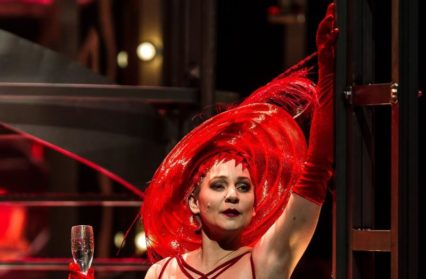Elin Williams reviews a Welsh National Opera performance of Lulu by composer Alban Berg under the direction of Artistic Associate David Pountney.
The first British performance of the incomplete opera ‘Lulu’ by composer Alban Berg was in 1971, and was notably produced by the Welsh National Opera. It was, therefore, extremely apt that it opened the company’s thematic season under the direction of the new Artistic Associate David Pountney. The opera, left incomplete after the death of Berg, was eventually completed by Friedrich Cerha once it became free of copyright. For this reason the piece is considered challenging, yet as it is so rich in relatable themes, notably the destructive power of women, the opera is incredibly interesting.
Welsh National Opera opted for a new edition prepared by Eberhard Kloke, ensuring a tidier, more rounded finish to the piece. The set, a large metal spiral centre stage, was adaptable and easy to dress, transforming at one point from a flamboyant Paris casino to the cold, hard streets of Victorian London. The set, combined with colourful lighting and lively costumes, ensured that the whole production was an assault on the senses. The production fully embraced the thematic intentions and didn’t pander to the audience’s expectations.
Lulu is the Hedda Gabler of the Opera world; the uncontrollable female, moulded by the demands of the society that encompasses her, an animal with the ability to control men and drive them mad. Brought on in the prologue as a symbolic snake needing to be ‘charmed’, the image sets precedent for Lulu’s ‘devilish’ behaviour. The prologue is presented as a human zoo, with the cast representing the animals through the use of enormous Greek style masks and headpieces. The whole scene looks positively terrifying, yet slightly humorous; it seems to be drawing attention to its own artificiality, harking back to the inevitable ‘All the World’s a Stage’.
Richard Angas plays the animal tamer, the puppet master, the father figure. His performance is far more consistent than the rest of the cast. He remains truthful and realistic throughout the production, whilst other cast members tend to get swept up in the extravagance of the piece and slip into overplay. Pountney cleverly changes the symbolic ‘portrait’ of Lulu into a fragmented sculpture. In keeping with the grotesqueness of the piece, the sculpture is present throughout, sometimes assembled, other times not, a strong indication of Lulu’s changeable, fragmented self.
Lulu is a character who demands a calm, hard portrayal. In order for the deviousness of her character to protrude however, there must be an underlying sensuality. Marie Arnet’s Lulu is certainly cold and unresponsive, but there doesn’t seem to be a hint of sexuality about her, certainly not in the first act. Consequently, the men are reacting in such a way which seems ridiculous, as such reactions are not being provoked by a maddening female. It needs to be more than that. Lulu is meant to be cunning, she is meant to work her way under their skin with a subtle yet apparent evidence of artful slyness.
Act two sees a more developed Lulu. She becomes more of a minx, more of a domineering female, and so the depleted reactions of Ashley Holland’s Doctor Schön are perfectly warranted. Lying naked on a disgusting bed resembling a woman’s naked body, Lulu is driven to murder Schön as he potentially threatens her womanly independence. As with the previous lovers who have perished under Lulu’s destructive power, Schön’s body is ceremoniously lifted to the ceiling, his corpse a constant reminder of the potential power of women.
The third act sees a massive jump in style and plot, almost definitely a consequence of a re-write. Although more interesting in plot, some characters are painfully dropped, whilst others are promoted and given an opportunity to shine. Peter Hoare’s Alwa, who is by this point wearing a disgruntled rabbit’s head and a straitjacket, is killed off without any climax, whilst Natascha Petrinsky is given a chance to really indulge as the desperate Geschwitz.
Petrinsky gives a heart-wrenching performance and becomes one of the most interesting characters, albeit right at the end of the production. Lulu, now a desperate prostitute working the murderous streets of London, is visited by her three former lovers, the last being Schön representing the infamous Jack the Ripper. Unfortunately, the reputation of such a brutal personality demanded a bit more from Holland, a stronger representation of a woman-hating psychopath. The climactic death of Lulu however is bloody and satisfying, whilst Petrisky’s dying Geschwitz is heroic and poignant.
The production, although a champion in set, is punctuated by jarring audio clips of dialogue, something which provoked confusion and disruption. The characters merely look at each other whilst the audio dialogue plays: a bizarre approach that ensures the complete halt of any character development. It seems the production wasn’t interested in character; the strongest character within the production was indeed its set. Although rich in thematic intention and pleasingly grotesque to the eye, both plot and character development leaves something lacking; something which restricts the audience from becoming fully engrossed in the production
Elin Williams has written a number of reviews for Wales Arts Review.











